News
Six countries were banned from FIFA World Cup
- Germany and Japan – 1950 World Cup
After World War II cancelled the 1942 and 1946 editions of the World Cup, the tournament resumed in 1950. But because of the outcome of World War II, Germany and Japan were not allowed to join.
Uruguay was the winner, followed by Brazil in second place, Sweden in third place and Spain in fourth place.
- South Africa – 1970 – 1990 World Cups
During apartheid in South Africa, they faced multiple international boycotts. They were suspended by FIFA in 1963 and finally expelled in 1976.
South Africa hosted the 2010 edition and is the last African country to host the tournament.
- Mexico – 1990 World Cup
FIFA slapped a two-year ban on Mexico for fielding four over-age players.
This incident happened during the qualifying round of the World Junior Championship.
The 1990 World Cup was won by West Germany, who beat Argentina in the final. Italy and England were third and fourth respectively.
- Chile – 1994 World Cup
Chilean goalkeeper Roberto Rojas pretended to be injured by a flare thrown by a fan during a 1989 match against Brazil.
In fact, he used a blade hidden in his glove to cut himself, resulting in FIFA banning Chile from the 1994 tournament. Rojas was banned for life.
- Myanmar – 2006 World Cup
In 2002, Myanmar was eliminated from a qualifying match for the World Cup in Iran.
They were fined $23,500 by FIFA and banned from the 2006 tournament in Germany.
- Russia – 2022 World Cup
After invading Ukraine, they were condemned by many countries around the world.
FIFA decided to ban the Russian football team from participating in the World Cup in Qatar.
The first match of the 2022 World Cup will begin on November 20.
FIFA ලෝක කුසලානයට ක්රීඩා කිරීම තහනම් කර ඇති රටවල් හයක්
- Germany and Japan – 1950 World Cup
දෙවන ලෝක යුද්ධය හේතුවෙන් ලෝක කුසලානයේ 1942 සහ 1946 තරගාවලි අවලංගු කිරීමෙන් පසුව, තරඟාවලිය 1950 දී නැවත ආරම්භ විය.
නමුත් දෙවන ලෝක යුද්ධයේ ප්රතිඵලය නිසා ජර්මනියට සහ ජපානයට සම්බන්ධ වීමට ඉඩ නොලැබුණි.
උරුගුවේ ජයග්රාහකයන් වූ අතර බ්රසීලය දෙවන ස්ථානයත්, ස්වීඩනය තුන්වන ස්ථානයත්, ස්පාඤ්ඤය සිව්වන ස්ථානයත් හිමිකර ගත්හ.
- South Africa – 1970 – 1990 World Cups
දකුණු අප්රිකාවේ වර්ණභේදවාදය අතරතුර, ඔවුන් බහුවිධ ජාත්යන්තර වර්ජනයන්ට මුහුණ දුන්හ. FIFA විසින් 1963 දී ඔවුන්ව අත්හිටුවන ලද අතර අවසානයේ 1976 දී නෙරපා හරින ලදී.
2010 සංස්කරණයේ සත්කාරකත්වය දැරූ දකුණු අප්රිකාව තරගාවලියේ සත්කාරකත්වය දැරූ අවසන් අප්රිකානු රට වේ.
- Mexico – 1990 World Cup
වයස් සීමාවට වඩා වැඩි ක්රීඩකයින් 4 දෙනෙකු ඉදිරිපත් කළ මෙක්සිකෝවට FIFA විසින් වසර දෙකක තහනමක් පැනවීය.
ලෝක කනිෂ්ඨ තරගාවලියේ සුදුසුකම් ලැබීමේ වටයේදී මෙම සිදුවීම සිදුව තිබේ.
1990 ලෝක කුසලානය බටහිර ජර්මනිය විසින් දිනා ගන්නා ලද අතර ඔවුන් අවසන් මහා තරගයේදී ආර්ජන්ටිනාව පරාජය කරන ලදී. ඉතාලිය සහ එංගලන්තය පිළිවෙලින් තුන්වන සහ සිව්වන ස්ථානයේ පසුවිය.
- Chile – 1994 World Cup
චිලී ගෝල රකින්නා වන රොබර්ටෝ රොජාස් 1989 දී බ්රසීලයට එරෙහිව තරගයේදී රසිකයෙක් විසින් විසි කරන ලද ගිනිදැල් නිසා තුවාල වූ බව මවා පෑවේය.
ඇත්ත වශයෙන්ම, ඔහු සිය අත්වැසුම් තුළ සැඟවුණු තලයක් භාවිතා කර තමාවම කපා ගත් අතර, එහි ප්රතිඵලයක් ලෙස FIFA 1994 තරඟාවලියෙන් චිලී කණ්ඩායමට තහනම් කළේය. රොජාස්ට ජීවිතාන්තය දක්වා තහනමක් පැනවීය.
- Myanmar – 2006 World Cup
2002 වසරේ ඉරානයේ පැවැත්වීමට නියමිතව තිබූ ලෝක කුසලාන තරගාවලියට සුදුසුකම් ලැබීමේ තරගයකින් මියන්මාරය ඉවත් විය.
ඔවුන්ට FIFA විසින් ඩොලර් 23,500 ක දඩයක් නියම කරන ලද අතර ජර්මනියේ පැවති 2006 තරඟාවලියේ තරඟාවලිය තහනම් කරන ලදී.
- Russia – 2022 World Cup
යුක්රේනය ආක්රමණය කිරීමෙන් පසු ඔවුන් ලොව පුරා බොහෝ රටවල් විසින් හෙළා දකින ලදී.
රුසියානු පාපන්දු කණ්ඩායම කටාර් ලෝක කුසලානයට සහභාගී වීම තහනම් කිරීමට FIFA තීරණය කළේය.
2022 ලෝක කුසලානයේ පළමු තරගය නොවැම්බර් 20 වැනිදා ආරම්භ වේ.
FIFA உலகக் கோப்பையில் பங்கேற்க 6 நாடுகள் தடை
- ஜெர்மனி மற்றும் ஜப்பான் – 1950 உலகக் கோப்பை
இரண்டாம் உலகப் போர் உலகக் கோப்பையின் 1942 மற்றும் 1946 பதிப்புகளை ரத்து செய்த பிறகு, போட்டி 1950 இல் மீண்டும் தொடங்கியது.
ஆனால் இரண்டாம் உலகப் போரின் விளைவாக ஜெர்மனியும் ஜப்பானும் சேர அனுமதிக்கப்படவில்லை.
உருகுவே வெற்றியீட்டியது, பிரேசில் இரண்டாவது இடத்திலும், ஸ்வீடன் மூன்றாவது இடத்திலும், ஸ்பெயின் நான்காவது இடத்திலும் உள்ளன.
- தென்னாப்பிரிக்கா – 1970 – 1990 உலகக் கோப்பைகள்
தென்னாப்பிரிக்காவில் நிறவெறியின் போது, அவர்கள் பல சர்வதேச புறக்கணிப்புகளை எதிர்கொண்டனர். அவர்கள் 1963 இல் FIFA ஆல் இடைநீக்கம் செய்யப்பட்டனர் மற்றும் இறுதியாக 1976 இல் வெளியேற்றப்பட்டனர்.
2010 பதிப்பை நடத்திய தென்னாப்பிரிக்கா, போட்டியை நடத்தும் கடைசி ஆப்பிரிக்க நாடு.
- மெக்சிகோ – 1990 உலகக் கோப்பை
வயதுக்கு மேற்பட்ட நான்கு வீரர்களை களமிறக்கியதற்காக மெக்சிகோவுக்கு ஃபிஃபா இரண்டு ஆண்டு தடை விதித்தது.
உலக ஜூனியர் சாம்பியன்ஷிப் போட்டியின் தகுதிச் சுற்றின் போது இந்த சம்பவம் நடந்துள்ளது.
1990 உலகக் கோப்பையை இறுதிப் போட்டியில் அர்ஜென்டினாவை வீழ்த்தி மேற்கு ஜெர்மனி வென்றது. இத்தாலி மற்றும் இங்கிலாந்து முறையே மூன்றாவது மற்றும் நான்காவது இடத்தில் உள்ளன.
- சிலி – 1994 உலகக் கோப்பை
சிலி கோல்கீப்பர் ராபர்டோ ரோஜாஸ் 1989 ஆம் ஆண்டு பிரேசிலுக்கு எதிரான போட்டியின் போது ஒரு ரசிகரால் வீசப்பட்ட ஃப்ளேயால் காயம் அடைந்தது போல் நடித்தார்.
உண்மையில், அவர் தனது கையுறையில் மறைத்து வைத்திருந்த பிளேடைப் பயன்படுத்தி தன்னைத் தானே வெட்டிக்கொண்டார், இதன் விளைவாக ஃபிஃபா 1994 போட்டியில் சிலியை தடை செய்தது. ரோஜாஸ்க்கு வாழ்நாள் தடை விதிக்கப்பட்டது.
- மியான்மர் – 2006 உலகக் கோப்பை
2002 இல், ஈரானில் நடைபெறவிருந்த உலகக் கோப்பைக்கான தகுதிச் சுற்றில் இருந்து மியான்மர் வெளியேறியது.
அவர்களுக்கு FIFA $23,500 அபராதம் விதித்தது மற்றும் ஜெர்மனியில் 2006 போட்டியில் இருந்து தடை செய்யப்பட்டது.
- ரஷ்யா – 2022 உலகக் கோப்பை
உக்ரைனை ஆக்கிரமித்த பிறகு, அவர்கள் உலகின் பல நாடுகளால் கண்டனம் செய்யப்பட்டனர்.
கத்தாரில் நடைபெறும் உலகக் கோப்பை கால்பந்து போட்டியில் ரஷ்ய கால்பந்து அணி பங்கேற்க தடை விதிக்க ஃபிஃபா முடிவு செய்துள்ளது.
2022 உலகக் கோப்பையின் முதல் போட்டி நவம்பர் 20 ஆம் தேதி தொடங்குகிறது.
Football
Lifebuoy Bodywash Ball Blaster 2025: Quarter-Final Lineup Shapes Up with Thrilling Group Stage Battles
The Lifebuoy Bodywash Ball Blaster 2025 has reached the most exciting stage yet as teams battle for quarter-final glory.
In Group B, Kalutara Central College has stamped their authority with 2 wins from 2 matches, boasting a flawless defense and an impressive +2 goal difference. The battle for the second spot is wide open between Royal College and Alighar Central College, both on 3 points and looking to secure their place in the knockout rounds. Maris Stella College has unfortunately bowed out after a tough group stage.
Meanwhile, Group C promises drama in the final match between St. Patrick’s College and St. Joseph’s College. A win for Joseph will see them top the group, while Patrick could sneak into the quarter-finals with a narrow 1-0 victory. A draw would favor Joseph’s qualification on goal difference.
The quarter-finals, scheduled for 5th November at City League, will feature the following fixtures:
- Q1: Zahira College, Colombo 🆚 Vaddakachchi Central College – 8:30 AM
- Q2: Kalutara Central College 🆚 St. Joseph’s College / St. Patrick’s College – 11:00 AM
- Q3: Gateway College/ St. Joseph’s College 🆚 Royal / Alighar – 1:30 PM
- Q4: Hameed Al Husseinie College 🆚 Darussalaam College – 4:00 PM
Fans can expect high-octane football and edge-of-the-seat action as Sri Lanka’s brightest school football talents compete for the prestigious Lifebuoy Bodywash Ball Blaster Trophy 2025. Stay tuned to Sri Lankan Sports TV for live coverage, match updates, and exclusive interviews.
Football
Group C Still Up for Grabs as Four Teams Eye Quarterfinal Spots in Lifebuoy Ball Blaster 2025!
The Lifebuoy Bodywash Ball Blaster 2025 Schools Football Championship Group C stage remains finely poised — with all four schools still in contention to reach the quarterfinals. With Gateway College having completed all their matches, the final fixtures will decide the fate of St. Benedict’s, St. Patrick’s, and St. Joseph’s Colleges.
Current Standings:
| School | M | W | L | D | GS | GA | GD | Points |
|---|---|---|---|---|---|---|---|---|
| Gateway College | 3 | 1 | 0 | 2 | 6 | 4 | +2 | 5 |
| St. Benedict’s College | 2 | 1 | 0 | 1 | 3 | 2 | +1 | 4 |
| St. Patrick’s College | 2 | 0 | 1 | 1 | 3 | 4 | -1 | 1 |
| St. Joseph’s College | 1 | 0 | 1 | 0 | 1 | 3 | -2 | 0 |
Gateway College – Top for Now 🟢
Gateway College leads with 5 points after finishing all their group-stage matches. Their unbeaten record gives them a strong edge, but their qualification still depends on the final two matchdays. They’ll be watching closely as St. Benedict’s and St. Patrick’s fight for crucial wins.
St. Benedict’s College – Advantage in Hand ⚪
With 4 points from 2 games, St. Benedict’s College holds the upper hand. A victory in their next match will guarantee a quarterfinal spot, potentially as Group winners. A draw could still be enough, but a defeat would leave them vulnerable to a late surge from the other two schools.
St. Patrick’s College – Still in the Race 🟡
With 1 point from 2 games, St. Patrick’s still has a chance to qualify — but only if they win the remaining match. They’ll also need to improve their goal difference, currently at -1, to stay competitive in case of a tie on points.
St. Joseph’s College – A Must-Win Situation 🔵
After losing their opening game, St. Joseph’s College faces a do-or-die scenario. With two matches left, the Josephians must win both — and by convincing margins — to stay in contention for a top-two finish. Anything less will end their campaign.
Qualification Scenarios:
- 🏆 If St. Benedict’s wins next match: Gateway and Benedict’s advance.
- 🤝 If St. Benedict’s draws next match: Gateway likely through; second spot open between Benedict’s and Patrick’s.
- ❌ If St. Benedict’s loses: St. Patrick’s or St. Joseph’s could qualify by winning their remaining games.
The Group C showdown promises edge-of-the-seat drama as school football’s finest battle for survival in the Lifebuoy Ball Blaster 2025. Every point counts — and one mistake could end a dream run.
Stay tuned to Sri Lankan Sports TV for live coverage, photos, and exclusive post-match reactions from the players and coaches.
Football
CBL Samaposha Continues to Empower Sri Lanka’s Young Footballers for the 14th Consecutive Year
In a remarkable display of commitment to grassroots sports development, CBL Samaposha continues its proud legacy of empowering the U14 Inter-School National Football Championship for the 14th consecutive year, reaffirming its role as one of Sri Lanka’s most consistent supporters of school-level football.
Organized by the Schools Football Association of Sri Lanka (SSFA), this year’s championship will take place across 32 regional grounds islandwide, drawing participation from over 12,000 young players representing 510 boys’ teams and 110 girls’ teams.

Provincial champions will advance to the final rounds in Galle, with matches scheduled at the Dadella Football Complex, B.T.S. School Grounds, and Galle Municipal Grounds. The grand final will be played at the Colombo Racecourse Grounds on December 13, where the nation’s most talented young players will compete for top honors.
CBL Foods’ Chief Executive Officer Mr. Manjula Dahanayake emphasized the company’s deep-rooted commitment to nurturing youth potential, saying:
“Our vision is to inspire young Sri Lankans to pursue their dreams through sport, discipline, and teamwork. Supporting this tournament helps build the next generation of leaders both on and off the field.”
SSFA CEO Mr. Iraj Wimalasuriya expressed appreciation for Samaposha’s continued partnership, stating:
“CBL Samaposha has been a true ally in our mission to strengthen school football. Their long-term commitment ensures that children from all parts of the island get an equal opportunity to play, compete, and grow.”
Adding further, Lt. Col. G.G. Anura Apevikrama, Director of Physical Education and Sports at the Ministry of Education, noted that this championship is often the first competitive experience for many budding footballers — a crucial step in building Sri Lanka’s sporting future.
As a proudly homegrown brand under CBL Plenty Foods (Pvt) Ltd, Samaposha continues to fuel the nation’s youth — both nutritionally and inspirationally — reinforcing the value of sportsmanship and unity through football.
🏆 About the Championship
- Organizer: Schools Football Association of Sri Lanka (SSFA)
- Sponsor: CBL Samaposha
- Players: Over 12,000 (Boys & Girls)
- Venues: 32 regional grounds, finals in Galle & Colombo
- Finals Date: December 13, 2025
-
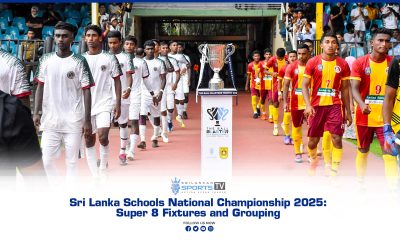
 Football9 months ago
Football9 months agoSri Lanka Schools National Championship 2025: Super 8 Fixtures and Grouping
-

 Live4 years ago
Live4 years agoLive Broadcast of Syria vs Sri Lanka | AFC U23 Asian Championship Qualification
-

 News9 months ago
News9 months ago2025 Schools Rugby Season Set to Thrill Fans with Knockout and League Action
-

 Cricket5 months ago
Cricket5 months agoNuwan Thushara Shines as RCB Storms into IPL 2025 Final
-
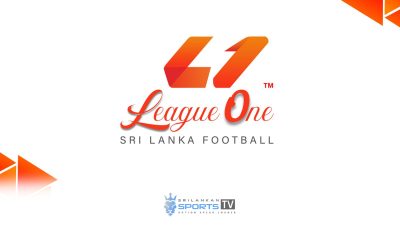
 Football10 months ago
Football10 months agoFFSL Rebrands Division-1 as ‘League-One’ with a Bold New Vision
-
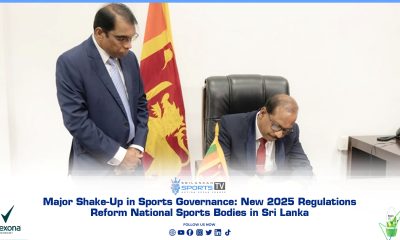
 News5 months ago
News5 months agoMajor Shake-Up in Sports Governance: New 2025 Regulations Reform National Sports Bodies in Sri Lanka
-
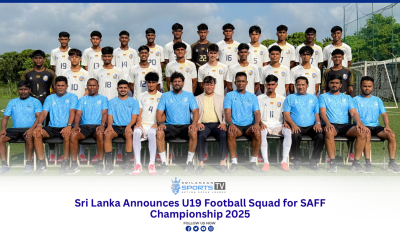
 Football6 months ago
Football6 months agoSri Lanka Announces U19 Football Squad for SAFF Championship 2025
-
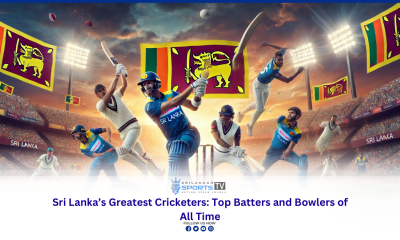
 Cricket9 months ago
Cricket9 months agoSri Lanka’s Greatest Cricketers: Top Batters and Bowlers of All Time







